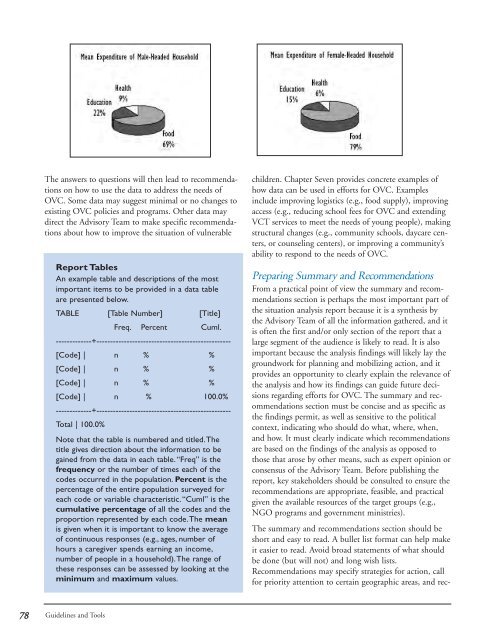Conducting a Participatory Situation Analysis of.pdf - Global HIV ...
Conducting a Participatory Situation Analysis of.pdf - Global HIV ...
Conducting a Participatory Situation Analysis of.pdf - Global HIV ...
Create successful ePaper yourself
Turn your PDF publications into a flip-book with our unique Google optimized e-Paper software.
The answers to questions will then lead to recommendations<br />
on how to use the data to address the needs <strong>of</strong><br />
OVC. Some data may suggest minimal or no changes to<br />
existing OVC policies and programs. Other data may<br />
direct the Advisory Team to make specific recommendations<br />
about how to improve the situation <strong>of</strong> vulnerable<br />
Report Tables<br />
An example table and descriptions <strong>of</strong> the most<br />
important items to be provided in a data table<br />
are presented below.<br />
TABLE [Table Number] [Title]<br />
Freq. Percent Cuml.<br />
-------------+-------------------------------------------------<br />
[Code] | n % %<br />
[Code] | n % %<br />
[Code] | n % %<br />
[Code] | n % 100.0%<br />
-------------+-------------------------------------------------<br />
Total | 100.0%<br />
Note that the table is numbered and titled.The<br />
title gives direction about the information to be<br />
gained from the data in each table.“Freq” is the<br />
frequency or the number <strong>of</strong> times each <strong>of</strong> the<br />
codes occurred in the population. Percent is the<br />
percentage <strong>of</strong> the entire population surveyed for<br />
each code or variable characteristic.“Cuml” is the<br />
cumulative percentage <strong>of</strong> all the codes and the<br />
proportion represented by each code.The mean<br />
is given when it is important to know the average<br />
<strong>of</strong> continuous responses (e.g., ages, number <strong>of</strong><br />
hours a caregiver spends earning an income,<br />
number <strong>of</strong> people in a household).The range <strong>of</strong><br />
these responses can be assessed by looking at the<br />
minimum and maximum values.<br />
children. Chapter Seven provides concrete examples <strong>of</strong><br />
how data can be used in efforts for OVC. Examples<br />
include improving logistics (e.g., food supply), improving<br />
access (e.g., reducing school fees for OVC and extending<br />
VCT services to meet the needs <strong>of</strong> young people), making<br />
structural changes (e.g., community schools, daycare centers,<br />
or counseling centers), or improving a community’s<br />
ability to respond to the needs <strong>of</strong> OVC.<br />
Preparing Summary and Recommendations<br />
From a practical point <strong>of</strong> view the summary and recommendations<br />
section is perhaps the most important part <strong>of</strong><br />
the situation analysis report because it is a synthesis by<br />
the Advisory Team <strong>of</strong> all the information gathered, and it<br />
is <strong>of</strong>ten the first and/or only section <strong>of</strong> the report that a<br />
large segment <strong>of</strong> the audience is likely to read. It is also<br />
important because the analysis findings will likely lay the<br />
groundwork for planning and mobilizing action, and it<br />
provides an opportunity to clearly explain the relevance <strong>of</strong><br />
the analysis and how its findings can guide future decisions<br />
regarding efforts for OVC. The summary and recommendations<br />
section must be concise and as specific as<br />
the findings permit, as well as sensitive to the political<br />
context, indicating who should do what, where, when,<br />
and how. It must clearly indicate which recommendations<br />
are based on the findings <strong>of</strong> the analysis as opposed to<br />
those that arose by other means, such as expert opinion or<br />
consensus <strong>of</strong> the Advisory Team. Before publishing the<br />
report, key stakeholders should be consulted to ensure the<br />
recommendations are appropriate, feasible, and practical<br />
given the available resources <strong>of</strong> the target groups (e.g.,<br />
NGO programs and government ministries).<br />
The summary and recommendations section should be<br />
short and easy to read. A bullet list format can help make<br />
it easier to read. Avoid broad statements <strong>of</strong> what should<br />
be done (but will not) and long wish lists.<br />
Recommendations may specify strategies for action, call<br />
for priority attention to certain geographic areas, and rec-<br />
78<br />
Guidelines and Tools















